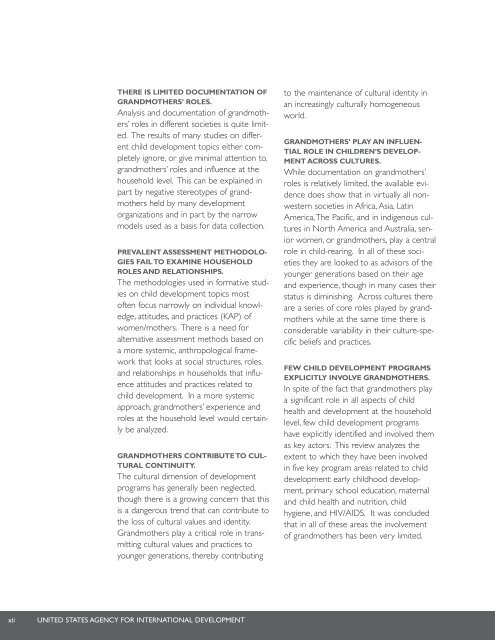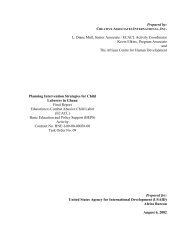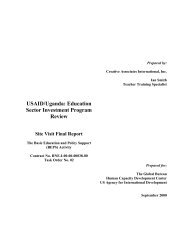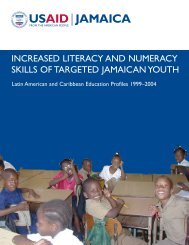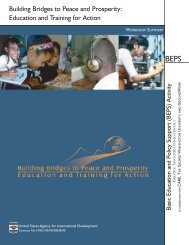Grandmothers: A Learning Institution - Basic Education and Policy ...
Grandmothers: A Learning Institution - Basic Education and Policy ...
Grandmothers: A Learning Institution - Basic Education and Policy ...
- No tags were found...
You also want an ePaper? Increase the reach of your titles
YUMPU automatically turns print PDFs into web optimized ePapers that Google loves.
THERE IS LIMITED DOCUMENTATION OFGRANDMOTHERS’ ROLES.Analysis <strong>and</strong> documentation of gr<strong>and</strong>mothers’roles in different societies is quite limited.The results of many studies on differentchild development topics either completelyignore, or give minimal attention to,gr<strong>and</strong>mothers’ roles <strong>and</strong> influence at thehousehold level. This can be explained inpart by negative stereotypes of gr<strong>and</strong>mothersheld by many developmentorganizations <strong>and</strong> in part by the narrowmodels used as a basis for data collection.PREVALENT ASSESSMENT METHODOLO-GIES FAIL TO EXAMINE HOUSEHOLDROLES AND RELATIONSHIPS.The methodologies used in formative studieson child development topics mostoften focus narrowly on individual knowledge,attitudes, <strong>and</strong> practices (KAP) ofwomen/mothers. There is a need foralternative assessment methods based ona more systemic, anthropological frameworkthat looks at social structures, roles,<strong>and</strong> relationships in households that influenceattitudes <strong>and</strong> practices related tochild development. In a more systemicapproach, gr<strong>and</strong>mothers’ experience <strong>and</strong>roles at the household level would certainlybe analyzed.GRANDMOTHERS CONTRIBUTE TO CUL-TURAL CONTINUITY.The cultural dimension of developmentprograms has generally been neglected,though there is a growing concern that thisis a dangerous trend that can contribute tothe loss of cultural values <strong>and</strong> identity.<strong>Gr<strong>and</strong>mothers</strong> play a critical role in transmittingcultural values <strong>and</strong> practices toyounger generations, thereby contributingto the maintenance of cultural identity inan increasingly culturally homogeneousworld.GRANDMOTHERS’ PLAY AN INFLUEN-TIAL ROLE IN CHILDREN’S DEVELOP-MENT ACROSS CULTURES.While documentation on gr<strong>and</strong>mothers’roles is relatively limited, the available evidencedoes show that in virtually all nonwesternsocieties in Africa, Asia, LatinAmerica,The Pacific, <strong>and</strong> in indigenous culturesin North America <strong>and</strong> Australia, seniorwomen, or gr<strong>and</strong>mothers, play a centralrole in child-rearing. In all of these societiesthey are looked to as advisors of theyounger generations based on their age<strong>and</strong> experience, though in many cases theirstatus is diminishing. Across cultures thereare a series of core roles played by gr<strong>and</strong>motherswhile at the same time there isconsiderable variability in their culture-specificbeliefs <strong>and</strong> practices.FEW CHILD DEVELOPMENT PROGRAMSEXPLICITLY INVOLVE GRANDMOTHERS.In spite of the fact that gr<strong>and</strong>mothers playa significant role in all aspects of childhealth <strong>and</strong> development at the householdlevel, few child development programshave explicitly identified <strong>and</strong> involved themas key actors. This review analyzes theextent to which they have been involvedin five key program areas related to childdevelopment: early childhood development,primary school education, maternal<strong>and</strong> child health <strong>and</strong> nutrition, childhygiene, <strong>and</strong> HIV/AIDS. It was concludedthat in all of these areas the involvementof gr<strong>and</strong>mothers has been very limited.xiiUNITED STATES AGENCY FOR INTERNATIONAL DEVELOPMENT


